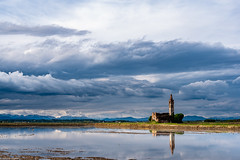Stewardship Pemberton explains how to love where you live. (Part 1: get to know it.)

What does it mean to love where you live?
Stewardship Pemberton, founded officially in 2007, is a community group dedicated to education and the protection and restoration of the natural environment. Having completed the One Mile Nature Centre, a project 7 years in the making, they’re embarking on a 5 year strategic planning exercise and surveyingthe community about what kind of programming you’d like to see at the Nature Centre.
We talked with Board members Veronica Woodruff (who we last spoke with when ground was breaking on the Centre in August 2010), Dawn Johnson and Jocelyn Sereda to find out what it means to be a steward.
What makes a steward and how do you know if you are one?
VW: Have you ever heard a bird call and wondered, ‘What is that? I hear it all the time?’Or have you thought, someone should really pick up that litter’, and then gone back and picked it up yourself?
Basically, if you care, you are a steward.
It could be caring about trees, animals, streams, air or even your food. And if you care, and are inspired to share your caring with others, than that makes you a purveyor of stewardship.
If you cared enough to participate in the Earth Day garbage clean-up, or if you care enough to tell your friend ‘I found out that bird making that call is a varied thrush, isn’t it beautiful!” then you are engaging in stewardship.
What is the nature of the Pemberton eco-system? Can you give us a run-down as to what bio-geo-climactic zones we’re in, and how that affects the wildlife that lives and travels through here?
VW: As far as biogeoclimatic zones, if you stood at the top of Mt. Currie you could see six if you consider all four valleys – south to Whistler, west to Meager volcanic complex, east to Lillooet-Harrison Lakes and north to Birkenhead/Anderson Lake.
Within these four valleys you will encounter six BEC zones including Coastal Western Hemlock, Interior Douglas Fir, Mountain Hemlock, Englemann Spruce-Subalpine Fir, Alpine Tundra and non-tidal wetlands.
That is what makes Pemberton unique, we are in a transitional zone both upwards and outwards, and it is these transitional zones that you find the greatest diversity.
This is true at this landscape scale and also the local level. The areas that border our lakes and wetlands, upland into the forest have the highest biodiversity which is why it is important to maintain this local connectivity.
What’s the difference between Stewardship Pemberton (SPS) and the Pemberton Wildlife Association (PWA), given that both have an interest in monitoring local wildlife?
VW: The PWA is primarily fish and wildlife focused, which incorporates hunting and fishing. SPS doesn’t have a focus on harvesting animals, though we are not against this practice. In fact, PWA is a strong partner in most of our intiatives. We also don’t have an advocacy role the way the group is currently set up. SPS is solely a stewardship group.
Is the One Mile Lake Nature Centre essentially the physical heart and HQ for Stewardship Pemberton?
VW: Yes and no. One Mile Lake Nature Centre was a massive accomplishment and it’s our headquarters, however our interest is really the 602,000 hectares of the Lillooet River Watershed.
How important is the One Mile Nature Centre to Stewardship Pemberton’s success?
VW: The Centre puts a face on our mission. It gives us a home base for our programming, but also a location for local people to come with questions. And it creates an opportunity to capture and inspire the passerby with a tiny tidbit of information that may blossom into a life changing attitude. (Yeah, we dream big, but it’s what happened to me).
We are experiencing a demand for the space but we have had a couple of set backs this winter with our infrastructure. Our solar power system didn’t function as anticipated and has required significant tweaking. Without power, we have no bathroom and with no bathroom, sadly, there is no rental.
Happily, we seem to be over the hump. Once we have all the kinks ironed out, the building will be available for rental.
What else goes on there?
VW: One Mile is amazing through the spring and summer. The lampreys should be spawning any minute in the channel, the beavers have been known to slap a tail at you in the evenings, the osprey have just returned to their nest on Lumpy’s and are actively feeding at the lake and the coho and sockeye will return in September through December.
You can always stop by the centre and borrow a pair of binoculars and a bird book. We are not open regular hours but anticipate hiring a student for part-time hours through the summer. Also, we are availabe to guide private groups. We have already had one group like this through. We have hosted a number of school groups for half day events. We have had parent tot walks. Our displays have included a salt water tank, Lil’wat Nation Traditional Territory model, local fauna exihibit.
The building will be available for functions and parties. What’s more Pemberton than an eco-birthday party?
+++
So, if you own a pair of rubberboots, wonder about bird calls, stop and marvel at sunsets, the salmon run or skunk cabbage, or have ever picked up a piece of litter, then you are hereby declared a Steward of Pemberton. Go like Stewardship Pemberton’s One Mile Lake Nature Centre page on facebook. Because they like you.








Comments
3 Responses to “Stewardship Pemberton explains how to love where you live. (Part 1: get to know it.)”Trackbacks
Check out what others are saying...[…] Last post, Stewardship Pemberton revealed the first step to loving where you live: get to know it. […]
[…] a more in-depth Q+A with Veronica about Stewardship Pemberton,visit here. Share this:TwitterFacebookLike this:LikeBe the first to like this. Category : Q+A Tags : […]
[…] Pique, food columnist Glenda Bartosh gave a short history on canning. Here at the Wellness Almanac, naturalist and blogger Dawn Johnson takes us elbow-deep into her own kitchen experiments in canning, and makes the emotional, social […]